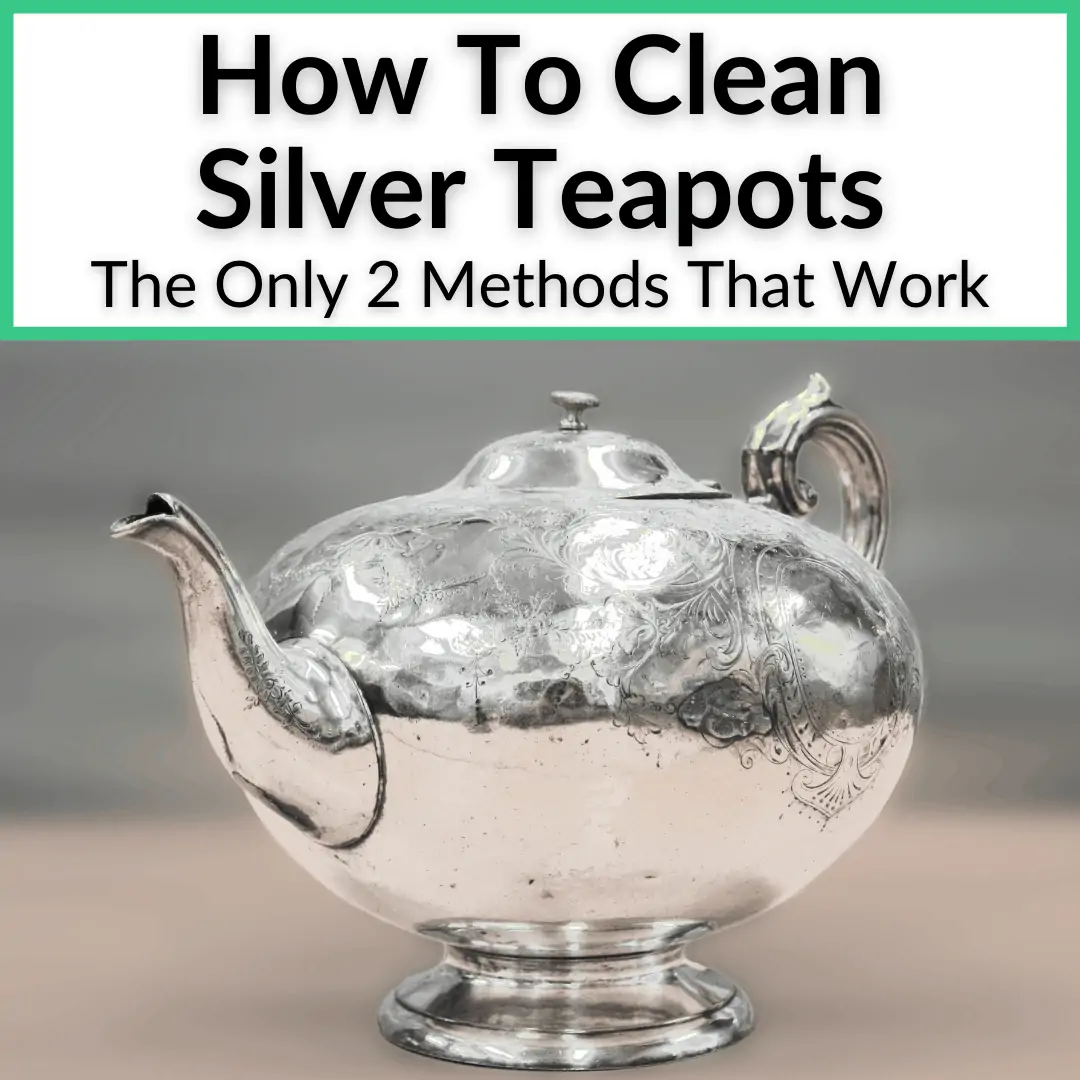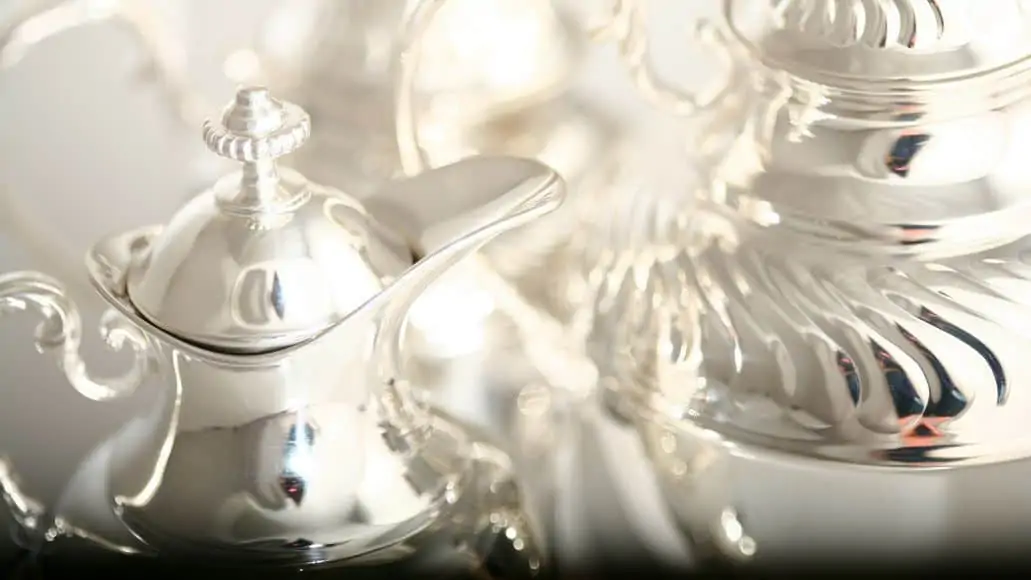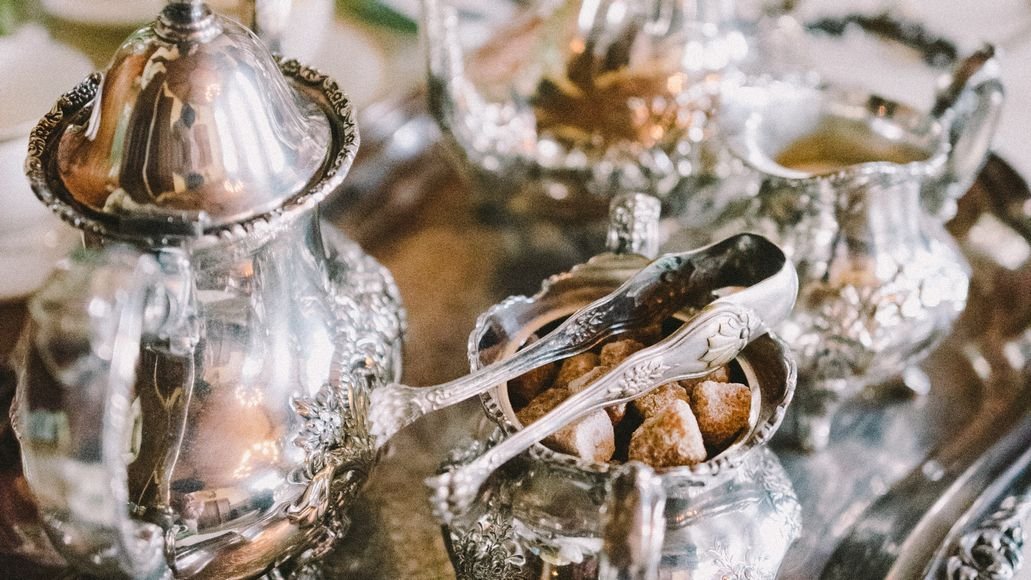
There are so many different methods out there, but few are actually effective.
Most leave you with a dirty teapot at best, and a scratched up and blemished one at worst.
So how do you clean silver teapots?
And do so in a way that leaves them in a perfect and brilliantly shiny condition?
Keep reading for complete step-by-step instructions for two different methods, one of which uses materials most of us already have at home.
Table of Contents
How To Clean Silver Teapots
There are several ways to clean silver teapots, but I found only two to be worthwhile and safe for the silver.
The first way is a natural way and the safest for your pot. It involves boiling water and using some household items. It is quite easy to do.

The second way is by using a premade specialty silver polish compound.
Both ways are safe for your silver, and do not take very long. I will cover both methods in detail, starting with the natural way using materials you probably already have in your home.
If you use your pot for everyday tea making, method one is the one I recommend. However, if your teapot is a display piece for your tearoom, method two will give you the wow factor you are looking for.
Method 1: Boiling Water And Baking Soda Method
This method is the preferred method of most people who use their silver teapots to make tea every day, because it is uses non-toxic materials that do not harm the environment.
It is also very inexpensive and only takes a few minutes. The end result is a nice shiny teapot.
The only downside to using this method is that you won’t get the extra shine and sparkle that method 2 provides.
Materials Needed
- Dish towel: any dish towel will do, but the softer the better
- Toothbrush: if you have a soft toothbrush that is the best option; some toothbrushes are very rigid and can leave micro scratches on the finish
- Baking soda: any brand will do, but I have only used Arm & Hammer for this job, and it works great
- Gloves (soft cotton gloves are best): a pair of simple soft cotton gloves will do the trick here
- Aluminum foil: I have personally only used Reynolds Wrap brand, but there is not much difference between brands of aluminum foil
- Salt: Morton’s salt is a good one for this job, and it is inexpensive if you buy the big package
- Large kitchen pot: the pot must be large enough to fit your teapot inside, so a basic saucepan or 2 quart pan is not going to cut it
- Hot water: straight from the tap is fine; you won’t need fancy distilled water or anything like that
Instructions
- Take a large sheet of aluminum foil and cover the entire bottom of the inside of the pot. Shape the foil to the shape of the pot. The foil is going to cause a chemical reaction that pulls the tarnish and grime off your pot. Yay science!
- Fill your large pot with water and turn on the stovetop, heating the water to a full boil.
- Add 3 big tablespoons of baking soda to the boiling water and stir it in completely.
- Add 3 tablespoons of salt to the mixture and stir it in with the baking soda.
- Submerge your teapot into the boiling mixture, being careful not to touch the water. Lower it in carefully so that it does not splash up onto your hands and burn you.
- Leave your teapot in the mixture for up to 30 minutes. Less time may be needed if your teapot is not too dirty.
- IMPORTANT STEP: Remove your teapot from the mixture carefully so you do not scratch it. As soon as it is out of the mixture, take a soft towel and dry it off completely. Do not let the teapot air dry because it will tarnish right before your eyes.
- Set your teapot on a table in some good light and inspect it for any remaining dirty spots or tarnished areas. If you see some areas that are not clean, you can make a baking soda paste with a small amount of water and use the toothbrush to gently scrub the area.
- Finally, if you still have some small areas that are not shiny and clean, you can put on your gloves and gently rub the areas until they are clean.
This method is a great way to clean your everyday silver teapot, but I have found that it does sometimes miss spots and does not provide a super shiny result.
However, there are no harsh chemicals being used and for an everyday teapot you do not need to give it an immaculate shine.
Method 2: Special Silver Polish Method

This method is a more hardcore method that will leave your silver teapot spotless and give it an immaculate luster that you simply cannot achieve with method #1.
The silver polish I recommend does not contain ammonia. It has a mildly abrasive formula that is so fine it will not cause any visible micro scratches
.
Materials Needed
- Silver polish: I recommend Weiman Silver Polish; it is not the only brand of silver polish, but it is the only one I have personally used multiple times with great results; the 8 ounce bottle should last you multiple cleanings
- Cotton gloves: these will be used for handling the finished silver teapot; fingerprints are a no-no on fine silver, so if you are going to be touching your teapot after it has been polished, wear some soft cotton gloves
- Two soft microfiber cloths: one will be used to apply the silver polish and one will be used to buff it out
- Large towel: a large beach towel or bathroom towel that is already dirty or is used for especially dirty jobs is ideal here; it will be used to cover the table or countertop on which you are working
Instructions
WARNING: Never put this cleaning solution on the inside of the teapot. It is fine if it is a little tarnished in there and you don’t want any residue ending up in your tea!
- Start off by taking your soft microfiber cloth and completely dust off the outside of your teapot. Start at the spout and work your way around the whole pot. This step will remove any debris or dust and prepare the surface for the next step.
- Next, squeeze a small amount (nickel size) of solution onto a microfiber cloth and begin gently rubbing it onto the spout of your teapot. It is going to feel like waxing a car. Small circles are a good idea here. Keep pressure on the cloth and work it into the silver. Continue this process, working in 4-5 inch sections, until the entire teapot has been rubbed with the solution. It will have a dull and powdery appearance when you finish this step.
- Put on your gloves. At this point you should not be touching your teapot with bare hands anymore.
- With your gloved hands, get your other unused microfiber cloth, and begin buffing out the powdery porous surface of your teapot. Frequently re-fold your cloth so that you are constantly using a fresh piece on each new section of your teapot. Put some elbow grease into it and take your time. The buffing is the magic step.
- When your teapot is completely shiny and beautiful, you are done!
Cleaning Silver Teapots: Final Thoughts
I’ve you’ve done any research online, you’ve likely come across tons of different methods for cleaning a silver teapot. I have only found the two methods above to be effective.
As mentioned previously, if you use your teapot for tea every day, go with method one. It does not use any chemicals. But if you need a perfect shine to show off your teapot, method two is better.
after cleaning with method two is there a product that I can apply to the silver for LONG term protection from oxidation? Many decades ago I remember my mother spraying a.fine.mist of hair spray (lacquer?) On them. thanks!
I am here for that question, as well, but have had pieces that came with a lacquer; however, they were trays and candy dishes. My husband has used a clear spray from a big box store for other things, such as faucets, with great success, and I was hoping that might work for teapots.
After polishing all my silver-plate pieces and before I enclose each one in its own flannel-made bag, I add a piece of white chalk into the bottom of the bag. I also place white chalk in the wooden silverware boxes and the open creamer and sugar pieces of the tea set which is displayed in my hutch. You will be amazed at how long the chalk keeps the pieces from tarnishing. It’s totally amazing.
Interesting tip, thank you!
These methods are great. I haven’t tried Weimans but I have used NeverDull. Itsworks well without scratching at all.
My concern is with my antique silver teapot and coffeepot. (They have wooden handles) They haven’t been used in over a generation, and as much as I try with boiling water and long scrubbers, I cannot get the spouts to smell clean. The water has an odd smell when i add boiling water. I even tried hot vinegar. It’s better since I tried that a few times but I think it will effect the tea.
Any suggestions for smelly old silver tea and coffee pots
Bi-carb soda method one should release the built up tannins and gunk.
How about the interior? Does the inside need to be as spotless as the outside. Or is a grey. Film ok?